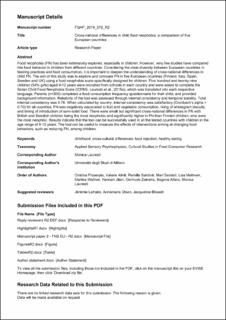| dc.contributor.author | Proserpio, C. | |
| dc.contributor.author | Almli, Valerie Lengard | |
| dc.contributor.author | Sandvik, P. | |
| dc.contributor.author | Sandell, M. | |
| dc.contributor.author | Methven, L. | |
| dc.contributor.author | Wallner, M. | |
| dc.contributor.author | Julani, H. | |
| dc.contributor.author | Zeinstra, G.G. | |
| dc.contributor.author | Alfaro, B. | |
| dc.contributor.author | Laureati, M. | |
| dc.date.accessioned | 2020-10-15T06:48:06Z | |
| dc.date.available | 2020-10-15T06:48:06Z | |
| dc.date.created | 2020-03-04T14:06:19Z | |
| dc.date.issued | 2020 | |
| dc.identifier.citation | Food Quality and Preference. 2020, 81 . | |
| dc.identifier.issn | 0950-3293 | |
| dc.identifier.uri | https://hdl.handle.net/11250/2682902 | |
| dc.description.abstract | Food neophobia (FN) has been extensively explored, especially in children. However, very few studies have compared this food behavior in children from different countries. Considering the clear diversity between European countries in feeding practices and food consumption, it is important to deepen the understanding of cross-national differences in child FN. The aim of this study was to explore and compare FN in five European countries (Finland, Italy, Spain, Sweden and UK) using a food neophobia scale specifically designed for children. Five hundred and twenty-nine children (54% girls) aged 9–12 years were recruited from schools in each country and were asked to complete the Italian Child Food Neophobia Scale (ICFNS, Laureati, Bergamaschi et al., 2015), which was translated into each respective language. Parents (n ≈ 300) completed a food consumption frequency questionnaire for their child, and provided background information. Reliability of the tool was assessed through internal consistency and temporal stability. Total internal consistency was 0.76. When calculated by country, internal consistency was satisfactory (Cronbach’s alpha >0.70) for all countries. FN was negatively associated to fruit and vegetable consumption, liking of wholegrain biscuits, and timing of introduction of semi-solid food. There were small but significant cross-national differences in FN with British and Swedish children being the most neophobic and significantly higher in FN than Finnish children, who were the most neophilic. Results indicate that the tool can be successfully used in all the tested countries with children in the age range of 9–12 years. The tool can be useful to measure the effects of interventions aiming at changing food behaviors, such as reducing FN, among children. | |
| dc.language.iso | eng | |
| dc.subject | Food rejection | |
| dc.subject | Food rejection | |
| dc.subject | Barndom | |
| dc.subject | Childhood | |
| dc.subject | Cross cultural differences | |
| dc.subject | Cross cultural differences | |
| dc.title | Cross-national differences in child food neophobia: A comparison of five European countries | |
| dc.type | Peer reviewed | |
| dc.type | Journal article | |
| dc.description.version | acceptedVersion | |
| dc.source.pagenumber | 9 | |
| dc.source.volume | 81 | |
| dc.source.journal | Food Quality and Preference | |
| dc.identifier.doi | 10.1016/j.foodqual.2019.103861 | |
| dc.identifier.cristin | 1799599 | |
| dc.relation.project | Norges forskningsråd: 233831 | |
| dc.relation.project | Nofima AS: 10862 | |
| dc.relation.project | Norges forskningsråd: 262308 | |
| dc.relation.project | Nofima AS: 201702 | |
| cristin.ispublished | true | |
| cristin.fulltext | postprint | |
| cristin.qualitycode | 1 | |
